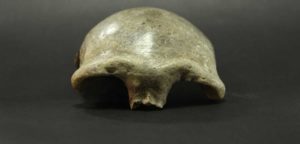
American Association for the Advancement of Science, Max Planck Institute for Evolutionary Anthropology, Arizona State University—In two studies, researchers provide evidence that expands our understanding of modern humans in Eurasia and their interactions with their most elusive cousins, the Denisovans. While admixture between humans and Denisovans is widely recognized, physical remains of the archaic hominin species are exceedingly rare. What’s more, ancient genomic evidence from early modern humans in eastern Asia, which would capture the nature of admixture events between the two species and inform on humans’ timing and movement into and across Asia, is lacking. Research conducted by separate teams has provided additional insight into early human population history in Eurasia.
Denisovan DNA in the Genome of Early East Asians
Max Planck Institute for Evolutionary Anthropology—In 2006, miners discovered a hominin skullcap with peculiar morphological features in the Salkhit Valley of the Norovlin county in eastern Mongolia. It was initially referred to as Mongolanthropus and thought to be a Neanderthal or even a Homo erectus. The remains of the “Salkhit” individual represent the only Pleistocene hominin fossil found in the country.
Ancient DNA extracted from the skullcap shows that it belonged to a female modern human who lived 34,000 ago and was more related to Asians than to Europeans. Comparisons to the only other early East Asian individual genetically studied to date, a 40,000-year-old male from Tianyuan Cave outside Beijing (China), show that the two individuals are related to each other. However, they differ insofar that a quarter of the ancestry of the Salkhit individual derived from western Eurasians, probably via admixture with ancient Siberians.
Migration and interaction
“This is direct evidence that modern human communities in East Asia were already quite cosmopolitan earlier than 34,000 years ago”, says Diyendo Massilani, lead author of the study and researcher at the Max-Planck Institute for Evolutionary Anthropology. “This rare specimen shows that migration and interactions among populations across Eurasia happened frequently already some 35,000 years ago”.
The researchers used a new method developed at the Max-Planck Institute for Evolutionary Anthropology to find segments of DNA from extinct hominins in the Salkhit and Tianyuan genomes. They found that the two genomes contain not only Neanderthal DNA but also DNA from Denisovans, an elusive Asian relative of Neanderthals. “It is fascinating to see that the ancestors of the oldest humans in East Asia from whom we have been able to obtain genetic data had already mixed with Denisovans, an extinct form of hominins that has contributed ancestry to present-day populations in Asia and Oceania”, says Byambaa Gunchinsuren, a researcher at the Institute of Archaeology of the Mongolian Academy of Sciences. “This is direct evidence that Denisovans and modern humans had met and mixed more than 40,000 years ago”.
“Interestingly, the Denisovan DNA fragments in these very old East Asians overlap with Denisovan DNA fragments in the genomes of present-day populations in East Asia but not with Denisovan DNA fragments in Oceanians. This supports a model of multiple independent mixture events between Denisovans and modern humans”, says Massilani.
____________________________

The skullcap found in the Salkhit Valley in eastern Mongolia belonged to a woman who lived 34,000 years ago. Analyses showed: She had inherited about 25 percent of her DNA from Western Eurasian. Institute of Archaeology, Mongolian Academy of Sciences
____________________________
New Denisovan DNA expands diversity, history of species
Arizona State University—While the continents of Africa and Europe have been obvious and fruitful treasure troves for exploration and discovery of our modern human origins, Asia has been somewhat overlooked. Scientists have thought that modern humans left Africa about 60,000 years ago and, as they colonized Western Eurasia, found a world empty of any other archaic hominin species. This assumption stemmed in part from the fact that the prehistory of Asia is poorly known compared to that of Africa and Europe.
But research* published this week in the journal Science adds more evidence to the record that Denisovans, a group of extinct hominins that diverged from Neanderthals about 400,000 years ago, may have more widely inhabited northeast central Asia. Ancient Denisovan mitochondrial DNA has been recovered in sediments from Baishiya Karst Cave, a limestone cave at the northeast margin of the Tibetan Plateau, 3280 meters above sea level. Samples of sediments were analyzed by an international team including ASU researcher Charles Perreault. Denisovan mitochondrial DNA was recovered that have been dated from around 100,000 to 60,000 years ago, and also possibly as recently as 45,000. If true, this last date may overlap with the presence of modern humans in northeast central Asia.
Perreault is a research affiliate with the Arizona State University Institute of Human Origins and an associate professor with the School of Human Evolution and Social Change.
“When we started developing this project about 10 years ago,” said Perreault, “none of us expected Baishya Cave to be such a rich site. We’ve barely scratched the surface — three small excavation units have yielded hundreds of stone tools, fauna and ancient DNA. There’s a lot that remains to be done.”
A mandible fossil (the “Xiahe mandible”) from the same cave and dated to 160,000, had been previously identified, tenuously, as Denisovan, based on a single amino acid position. This current study dispels any doubt left that the Denisovans occupied the cave.
This discovery in Baishiya Karst Cave is the first time Denisovan DNA has been recovered from a location that is outside Denisova Cave in Siberia, Russia — previously the single location in the world where a handful of DNA-bearing Denisovan fossil bones have been discovered. In 2010, a fingerbone belonging to a previously unknown hominin species was found buried in Denisova Cave in the Russian Altai Mountains. Evidence of this new species forced anthropologists to revise their model of human evolution outside of Africa.
Finding Denisovan DNA on the Tibetan Plateau itself is surprising. Evidence of archaic hominins 2000 meters above sea level is unusual. Life this high on the plateau is harsh for many reasons, including its thin air, and humans can develop altitude sickness anywhere above 2500 meters above sea level. This suggests that the Denisovans may have evolved adaptations to high altitude, much like modern Tibetans. The dates of the sediments with mitochondrial DNA, along with the older 160,000-year-old Xiahe mandible, suggest that the Denisovans have been on the Plateau perhaps continuously for tens of thousands of years — more than enough for genetic adaptations to emerge.
Getting DNA samples from geographic locations outside of Siberia is also important to understand the genetic diversity and the population structure and history of the Denisovan group as a whole. Researchers suspected that Denisovans were widespread in Asia, based on the widespread Denisovan genomic signal among present-day Asians.
The Denisovan fossil and the DNA it contained, indicate that early modern humans coexisted in Asia with other archaic hominin species, but, unexpectedly, that they interbred with them. Like Neanderthals, Denisovan population intermixed with modern humans as they dispersed into Asia. In fact, there’s evidence that the genetic adaptations to high altitude in present-day Tibetans come from Denisovans. If confirmed, this is a great example of how intermixing with local archaic populations has shaped, and helped, the spread of modern humans around the world. In this case, it allowed humans to colonize the Tibetan Plateau perhaps faster than they would otherwise have been able to.
“Baishiya Cave is an extraordinary site that hold tremendous potential to understand human origins in Asia,” said Charles Perreault. “Future work in Baishiya Cave may give us a truly unique access to Denisovan behavior and solidifies the picture that is emerging, which is that Denisovans, like Neanderthals, were not mere offshoots of the human family tree — they were part of a web of now-extinct populations that contributed to the current human gene pool and shaped the evolution of our species in ways that we are only beginning to understand.”
____________________________

Tibet cave site. Charles Perreault
____________________________
*”Denisovana DNA in Late Pleistocene sediments from Baishiya Kartst Cave on the Tibetan Plateau,” Science. Dongju Zhang et al.
Article Sources: American Association for the Advancement of Science, Max Planck Institute for Evolutionary Anthropology, and Arizona State University news releases
____________________________
Advertisement



